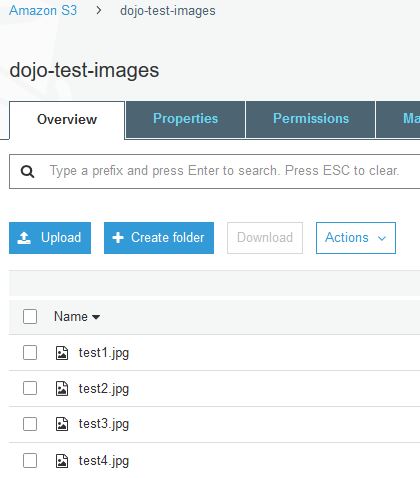45 aws rekognition detect custom labels
Rekognition — Boto3 Docs 1.24.35 documentation Creates a new Amazon Rekognition Custom Labels project. A project is a group of resources (datasets, model versions) that you use to create and manage Amazon Rekognition Custom Labels models. This operation requires permissions to perform the rekognition:CreateProject action. See also: AWS API Documentation. Request Syntax Amazon now lets customers label and track specific objects with Rekognition Amazon Web Services (AWS) today announced that Rekognition, its cloud-based software-as-a-service computer vision platform, will soon gain custom labels that'll allow customers to craft object ...
What Is Amazon Rekognition Custom Labels? The Amazon Rekognition Custom Labels console provides a visual interface to make labeling your images fast and simple. The interface allows you to apply a label to the entire image. You can also identify and label specific objects in images using bounding boxes with a click-and-drag interface.

Aws rekognition detect custom labels
Using Amazon Rekognition Custom Labels and Amazon A2I ... - aws.amazon.com For instructions on creating a project, see Creating an Amazon Rekognition Custom Labels Project. On the Amazon Rekognition console, choose Custom Labels. Choose Get started. For Project name, enter a2i-rekog-pepperoni-pizza. Choose Create project. Creating a dataset To create your dataset, complete the following steps: AWS Tutorials - Create Custom Models using Amazon Rekognition Custom Labels The Workshop URL - Rekognition Custom Labels help in identifying the objects and scenes in images tha... AWS launches Amazon Rekognition Custom Labels to enable customers find ... Posted On: Dec 3, 2019 Today, Amazon Web Services (AWS) launched Amazon Rekognition Custom Labels, a new feature of Amazon Rekognition that enables customers to build their own machine learning (ML) based image analysis capabilities to detect unique objects and scenes, relevant to their business need.
Aws rekognition detect custom labels. Amazon Rekognition Custom Labels Behind the scenes, Rekognition Custom Labels automatically loads and inspects the training data, selects the right machine learning algorithms, trains a model, and provides model performance metrics. You can then use your custom model via the Rekognition Custom Labels API and integrate it into your applications. Use cases (ResourceNotReadyException):Error when calling ... - AWS re:Post The line above needs to be called after the training and it should be ensured that the model Status has changed to RUNNING before calling the detect_custom_labels() method. Comment rekoguser GitHub - aws-samples/serverless-rekognition-custom-labels The process of training the model is described step by step in the blog post with the use of the notebooks. 1 - Access the AWS CloudFormation console and deploy the template.yaml as a new stack. 2 - Run noteboos/1_prepare_data.ipynb to download and preprocess the data into the S3 bucket. 3 - Use Amazon Rekognition Custom Labels to train an ... amazon-rekognition-custom-ppe-detection-with-custom-labels ... - GitHub Training Workflow Call Flow. Web application uploads image(s) to source S3 bucket. (_Note: Amazon S3 Transfer Accelection is used to reduce the upload time by taking advantage of the global Amazon CloudFront edge locations) Send a POST /analyze request, specified labelOnly=true query parameter to indicate using Rekognition.DetectLabels API only
Using Amazon Rekognition Custom Labels from R to train a Swoosh ... R users can access and use Amazon Rekognition Custom Labels using the fabulous paws package, an AWS SDK for R, created by David Kretch and Adam Banker. In this article, we will use Rekognition Custom Labels to train an object detection model to detect the Swoosh, Nike's famous logo that Carolyn Davidson designed in 1971: AWS Rekognition Custom Labelsで食品画像認識 - Qiita AWS Rekognition Custom Labelsが食品認識に利用できそうなことは判りました。 任意でラベルを定義し、推定させた画像をデータセットに追加して定期的にモデルの学習をすれば、想定していたフローが実現できそうです。 Rekognition Custom Labels Max Results | AWS re:Post That means, you can train a model that can classify/detect 250 unique labels. Maximum number of labels per image is 50. That means, you can add maximum 50 labels/bounding boxes to your each image. Please refer this public documentation for more details. AWS-Pavan detect-custom-labels missing from AWS CLI (Windows) I am following instructions both here - and on the AWS Console itself in order to test recognition against a model / dataset I have built using custom labels.
Machine learning: analyzing images with Amazon Rekognition Custom Labels AWS CLI; Amazon Rekognition Custom Labels; AWS IAM Via the AWS Management Console you find the IAM service in section Security, Identity, & Compliance. You need to create a group and a user in that group with sufficient rights. ... aws rekognition detect-custom-labels \ -project-version-arn "arn:aws:rekognition:eu-west-1:938506314627 ... Understanding Amazon Rekognition Custom Labels Amazon Rekognition Custom Labels can label the images using the folder names that contain the images. Import an Amazon SageMaker Ground Truth manifest file. Copy an existing Amazon Rekognition Custom Labels dataset. For more information, see Creating training and test datasets (Console). Amazon Rekognition Custom Labels Community Showcase Amazon Rekognition Custom Labels allows you to detect custom labeled objects and scenes with zero Jupyter notebook experience. For example, you can identify logos in streaming media, simplify preventative maintenance, and scale supply chain inventory management. Real-world usage of Rekognition w/ Custom Labels : aws To be clear for anyone else reading this later, your statement applies explicitly to Rekognition Custom Labels (or any other Rekognition service that requires starting/stopping a trained AI). Rekognition Detect Labels (the base service) is intended to be used exactly like you describe (few standalone requests here and there) and very inexpensive.
detect-custom-labels — AWS CLI 2.1.29 Command Reference detect-custom-labels ¶ Description ¶ Detects custom labels in a supplied image by using an Amazon Rekognition Custom Labels model. You specify which version of a model version to use by using the ProjectVersionArn input parameter. You pass the input image as base64-encoded image bytes or as a reference to an image in an Amazon S3 bucket.
Detecting labels in an image - Amazon Rekognition You can use the DetectLabels operation to detect labels in an image. For an example, see Analyzing images stored in an Amazon S3 bucket. The following examples use various AWS SDKs and the AWS CLI to call DetectLabels. For information about the DetectLabels operation response, see DetectLabels response. To detect labels in an image
rekognition — AWS CLI 2.7.18 Command Reference Description¶. This is the API Reference for Amazon Rekognition Image, Amazon Rekognition Custom Labels, Amazon Rekognition Stored Video, Amazon Rekognition Streaming Video.It provides descriptions of actions, data types, common parameters, and common errors.
Getting started with Amazon Rekognition Custom Labels Sign in to the AWS Management Console and open the Amazon Rekognition console at . In the left pane, choose Use Custom Labels. The Amazon Rekognition Custom Labels landing page is shown. If you don't see Use Custom Labels, check that the AWS Region you are using supports Amazon Rekognition Custom Labels.
Batch image processing with Amazon Rekognition Custom Labels | AWS ... Amazon Rekognition Custom Labels provides a simple end-to-end experience where you start by labeling a dataset, and Amazon Rekognition Custom Labels builds a custom ML model for you by inspecting the data and selecting the right ML algorithm. After your model is trained, you can start using it immediately for image analysis.
detect-custom-labels — AWS CLI 1.22.60 Command Reference detect-custom-labels ¶ Description ¶ Detects custom labels in a supplied image by using an Amazon Rekognition Custom Labels model. You specify which version of a model version to use by using the ProjectVersionArn input parameter. You pass the input image as base64-encoded image bytes or as a reference to an image in an Amazon S3 bucket.
detect-custom-labels — AWS CLI 2.7.12 Command Reference rekognition] detect-custom-labels¶ Description¶ Detects custom labels in a supplied image by using an Amazon Rekognition Custom Labels model. You specify which version of a model version to use by using the ProjectVersionArninput parameter. You pass the input image as base64-encoded image bytes or as a reference to an image in an Amazon S3 bucket.
AWS launches Amazon Rekognition Custom Labels to enable customers find ... Posted On: Dec 3, 2019 Today, Amazon Web Services (AWS) launched Amazon Rekognition Custom Labels, a new feature of Amazon Rekognition that enables customers to build their own machine learning (ML) based image analysis capabilities to detect unique objects and scenes, relevant to their business need.
AWS Tutorials - Create Custom Models using Amazon Rekognition Custom Labels The Workshop URL - Rekognition Custom Labels help in identifying the objects and scenes in images tha...
Using Amazon Rekognition Custom Labels and Amazon A2I ... - aws.amazon.com For instructions on creating a project, see Creating an Amazon Rekognition Custom Labels Project. On the Amazon Rekognition console, choose Custom Labels. Choose Get started. For Project name, enter a2i-rekog-pepperoni-pizza. Choose Create project. Creating a dataset To create your dataset, complete the following steps:
















Post a Comment for "45 aws rekognition detect custom labels"